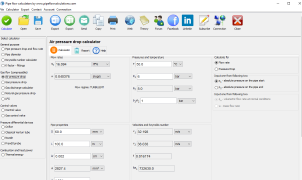Gas Discharge Flow Calculator for Choked and Subsonic Gas Flow Conditions
Calculate Gas Flow Through Valves and Pipes Under Pressure Differential
Online Calculator
This calculator is not available as Online app.
Desktop App

Desktop full-featured version.
Free Trial AvailableRegistration
Select a fair price and enable the full service:
- Switch between metric and imperial units in one click
- Export calculation results in Word .docx or Excel .xlsx format
- Preview results on one place and copy/paste it in your favorite text editor
- Send results back to your email
- Support the future of this project
And even more... get access to the full set of 19 desktop calculators available for MacOS, Linux or Windows.
Full Year Service
Prepaid Monthly Cost
$2.50/month
Full year $29.95/year
When is this calculator suitable?
The Gas discharge flow calculator is a specialized tool designed to compute the flow rate of gases exiting pipelines or reservoirs, considering factors such as pressure differences, pipe diameters, and the presence of valves and fittings.
It supports calculations for various two- and three-atomic gases, including air, nitrogen, and carbon dioxide, under steady flow conditions with constant pressures.
The calculator employs the Darcy formula, modified for gas flow, and utilizes the Colebrook-White equation to determine friction factors. It also assesses whether the flow is choked and provides relevant calculations for such scenarios. Users can input parameters like resistance coefficients for valves and fittings, as well as pipeline surface roughness, to obtain accurate results.
You can use the calculator for flow in pipelines that include valves and fittings. You can calculate the maximum flow rate when you know pressure difference and pipe diameter, or you can calculate pipe diameter when you know flow rate and pressure drop.
The calculator is applicable for all two and three atomic gases, like air, nitrogen, carbon dioxide and other gases. The calculator is suitable for steady flow with constant pressures at one point of streamline.
What are the calculator restrictions?
The calculator is suitable for ideal gases, as the calculator uses the equation of state for ideal gas during calculation. The calculator is not applicable for non-steady, pulsating flow.
How is the calculation executed?
Based on the known pressure difference (head loss) between one point of flow stream at the start of a pipe or in front of a valve, to the outside point (like atmosphere), or after a valve with known inside pipe diameter, mass flow rate, and volume discharge flow rate is calculated. The calculator uses a modified Darcy formula for flow rate calculation.
where is:
w - offtake mass flow rate [kg/s]
Y - expansion factor [ - ]
d - internal pipe diameter [mm]
Δp - pressure drop [Pa]
ρ - density [kg/m3]
K - resistance coefficient [ - ]
The calculator is calculating a friction coefficient using the Colebrook-White formula:
where is:
f - friction factor [ - ]
k - pipe roughness [mm]
D - internal pipe diameter [mm]
Re - Reynolds number [ - ]
The gas discharge calculator presents Reynolds number and expansion factor as calculation results.
The calculator is checking if a flow is choked or not and presents choked flow status. For choked flow conditions, the calculator is calculating the flow rate for that condition.
What else has to be known to perform the gas discharge calculation?
You should enter resistance factor K for valves and fittings if they exist in the pipeline as well as pipeline surface roughness.
When is this calculator not relevant?
The calculator is not relevant for liquids.
Register account and unlock full access
Desktop App

Fast. Accurate. Reliable.
Features in desktop app
- Save/Open multiple results
- Export to Word and Excel
- Print results
- Create list of custom fluid properties
- Resistance factor K for valves/fittings
- Pipe surface roughness selection
- Pipe material selection
- Gauge vs absolute pressure toggle
- Compressible isothermal flow
- Dry air isothermal flow
- Gas offtake flow
- Natural gas flow
- No admin rights required to install
Need a helping hand?
Powered by natural intelligence - NI

If you need a quick calculation, but you are not still familiar how to use the calculator, you can order calculation service from the calculator developer.




